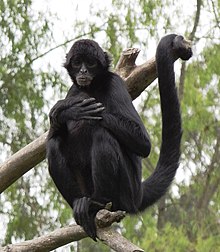Spider monkey
| Spider monkey | |
|---|---|
 |
|
| Black-headed spider monkey (Ateles fusciceps) | |
| Scientific classification | |
| Kingdom: | Animalia |
| Phylum: | Chordata |
| Class: | Mammalia |
| Order: | Primates |
| Suborder: | Haplorhini |
| Family: | Atelidae |
| Subfamily: | Atelinae |
| Genus: |
Ateles E. Geoffroy, 1806 |
| Type species | |
|
Simia paniscus Linnaeus, 1758 |
|
| Species | |
|
Ateles belzebuth |
|
 |
|
| Range of the spider monkeys | |
Ateles belzebuth
Ateles chamek
Ateles hybridus
Ateles marginatus
Ateles fusciceps
Ateles geoffroyi
Ateles paniscus
Spider monkeys of the genus Ateles are New World monkeys in the subfamily Atelinae, family Atelidae. Like other atelines, they are found in tropical forests of Central and South America, from southern Mexico to Brazil. The genus contains seven species, all of which are under threat; the black-headed spider monkey, and brown spider monkey are critically endangered.
Disproportionately long limbs and long prehensile tails make them one of the largest New World monkeys and give rise to their common name. Spider monkeys live in the upper layers of the rainforest, and forage in the high canopy, from 25 to 30 m (82 to 98 ft). They primarily eat fruits, but will also occasionally consume leaves, flowers, and insects. Due to their large size, spider monkeys require large tracts of moist evergreen forests, and prefer undisturbed primary rainforest. They are social animals and live in bands of up to 35 individuals but will split up to forage during the day.
Recent meta-analyses on primate cognition studies indicated spider monkeys are the most intelligent New World monkeys. They can produce a wide range of sounds and will "bark" when threatened; other vocalisations include a whinny similar to a horse and prolonged screams.
...
Wikipedia
